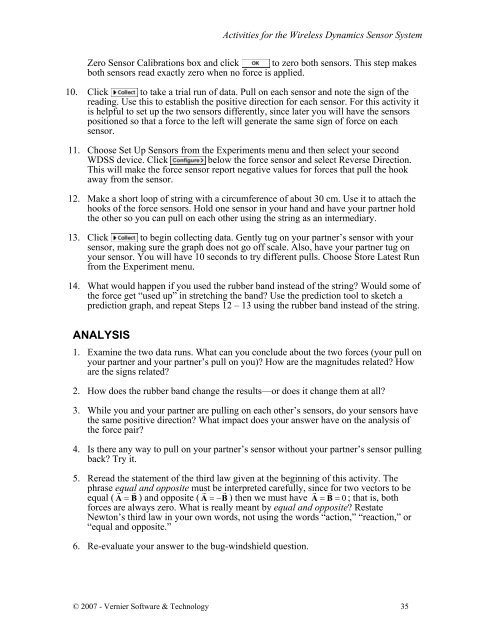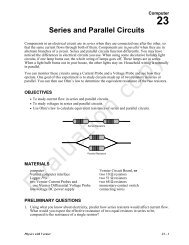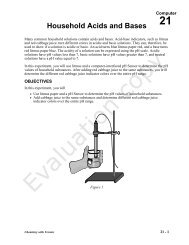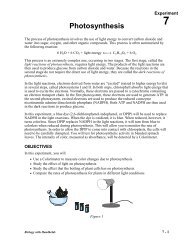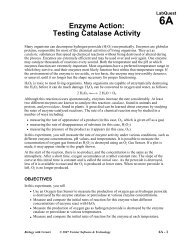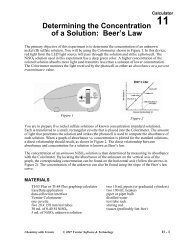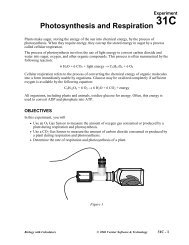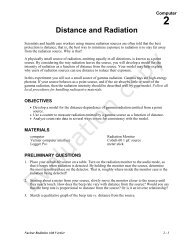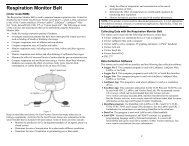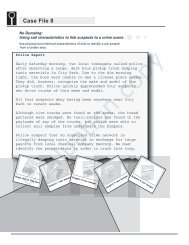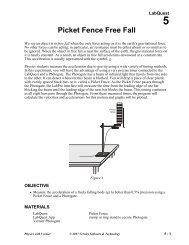Activities for the Wireless Dynamics Sensor System - Vernier ...
Activities for the Wireless Dynamics Sensor System - Vernier ...
Activities for the Wireless Dynamics Sensor System - Vernier ...
You also want an ePaper? Increase the reach of your titles
YUMPU automatically turns print PDFs into web optimized ePapers that Google loves.
<strong>Activities</strong> <strong>for</strong> <strong>the</strong> <strong>Wireless</strong> <strong>Dynamics</strong> <strong>Sensor</strong> <strong>System</strong>Zero <strong>Sensor</strong> Calibrations box and click to zero both sensors. This step makesboth sensors read exactly zero when no <strong>for</strong>ce is applied.10. Click to take a trial run of data. Pull on each sensor and note <strong>the</strong> sign of <strong>the</strong>reading. Use this to establish <strong>the</strong> positive direction <strong>for</strong> each sensor. For this activity itis helpful to set up <strong>the</strong> two sensors differently, since later you will have <strong>the</strong> sensorspositioned so that a <strong>for</strong>ce to <strong>the</strong> left will generate <strong>the</strong> same sign of <strong>for</strong>ce on eachsensor.11. Choose Set Up <strong>Sensor</strong>s from <strong>the</strong> Experiments menu and <strong>the</strong>n select your secondWDSS device. Click below <strong>the</strong> <strong>for</strong>ce sensor and select Reverse Direction.This will make <strong>the</strong> <strong>for</strong>ce sensor report negative values <strong>for</strong> <strong>for</strong>ces that pull <strong>the</strong> hookaway from <strong>the</strong> sensor.12. Make a short loop of string with a circumference of about 30 cm. Use it to attach <strong>the</strong>hooks of <strong>the</strong> <strong>for</strong>ce sensors. Hold one sensor in your hand and have your partner hold<strong>the</strong> o<strong>the</strong>r so you can pull on each o<strong>the</strong>r using <strong>the</strong> string as an intermediary.13. Click to begin collecting data. Gently tug on your partner’s sensor with yoursensor, making sure <strong>the</strong> graph does not go off scale. Also, have your partner tug onyour sensor. You will have 10 seconds to try different pulls. Choose Store Latest Runfrom <strong>the</strong> Experiment menu.14. What would happen if you used <strong>the</strong> rubber band instead of <strong>the</strong> string? Would some of<strong>the</strong> <strong>for</strong>ce get “used up” in stretching <strong>the</strong> band? Use <strong>the</strong> prediction tool to sketch aprediction graph, and repeat Steps 12 – 13 using <strong>the</strong> rubber band instead of <strong>the</strong> string.ANALYSIS1. Examine <strong>the</strong> two data runs. What can you conclude about <strong>the</strong> two <strong>for</strong>ces (your pull onyour partner and your partner’s pull on you)? How are <strong>the</strong> magnitudes related? Howare <strong>the</strong> signs related?2. How does <strong>the</strong> rubber band change <strong>the</strong> results—or does it change <strong>the</strong>m at all?3. While you and your partner are pulling on each o<strong>the</strong>r’s sensors, do your sensors have<strong>the</strong> same positive direction? What impact does your answer have on <strong>the</strong> analysis of<strong>the</strong> <strong>for</strong>ce pair?4. Is <strong>the</strong>re any way to pull on your partner’s sensor without your partner’s sensor pullingback? Try it.5. Reread <strong>the</strong> statement of <strong>the</strong> third law given at <strong>the</strong> beginning of this activity. Thephrase equal and opposite must be interpreted carefully, since <strong>for</strong> two vectors to beequal ( r rr rA = B) and opposite ( A = − B) <strong>the</strong>n we must have Ar = Br= 0 ; that is, both<strong>for</strong>ces are always zero. What is really meant by equal and opposite? RestateNewton’s third law in your own words, not using <strong>the</strong> words “action,” “reaction,” or“equal and opposite.”6. Re-evaluate your answer to <strong>the</strong> bug-windshield question.© 2007 - <strong>Vernier</strong> Software & Technology 35


